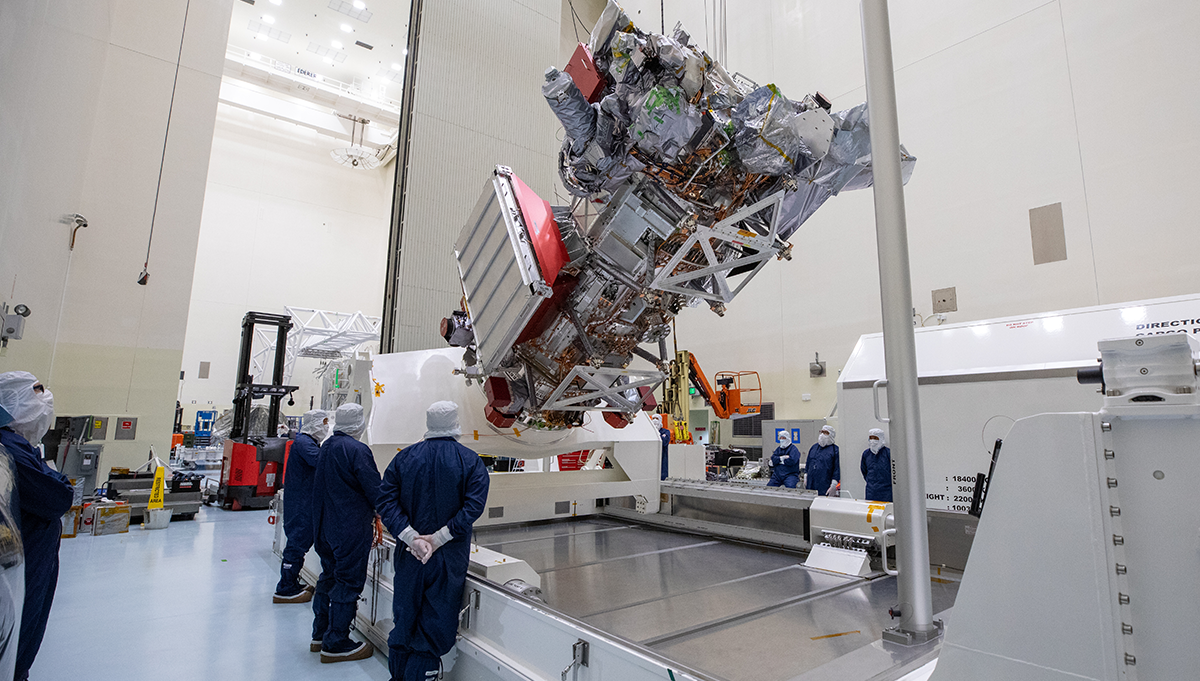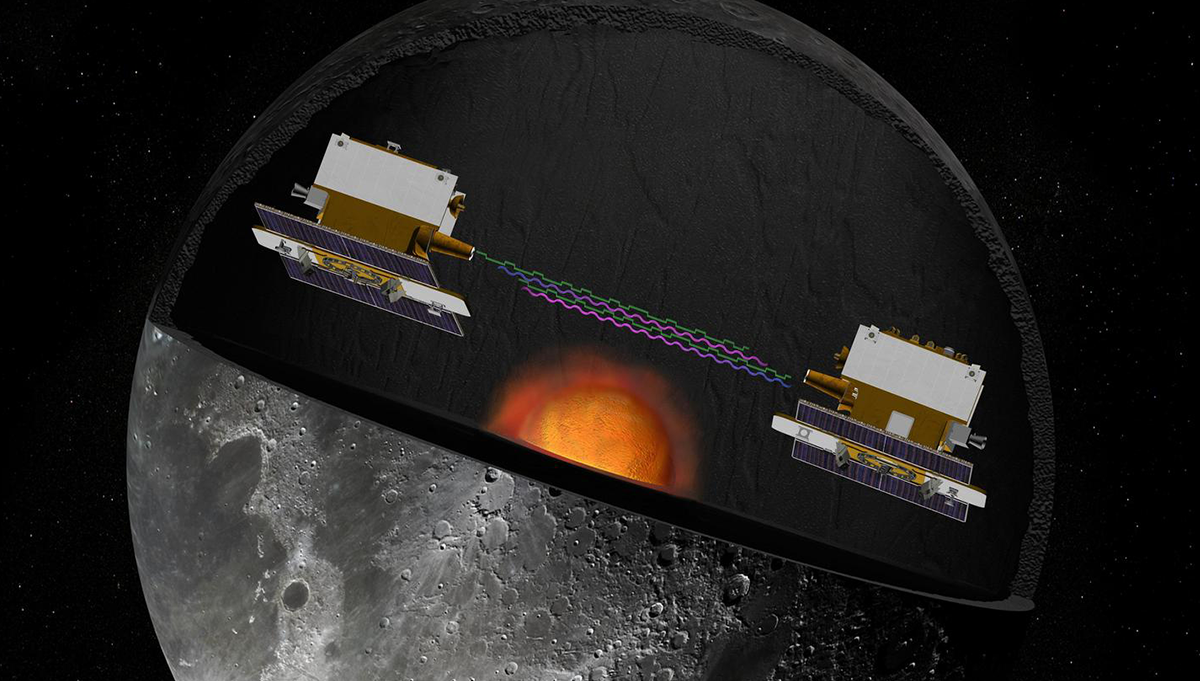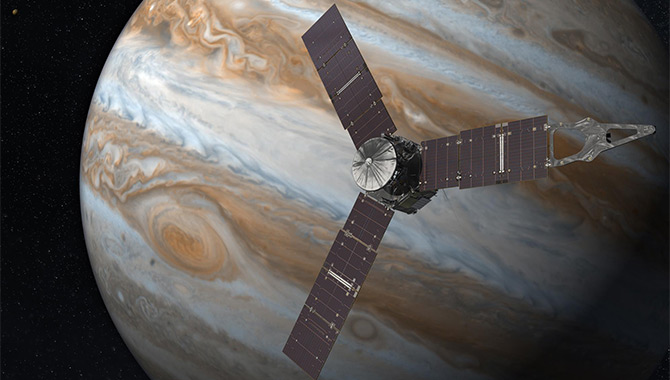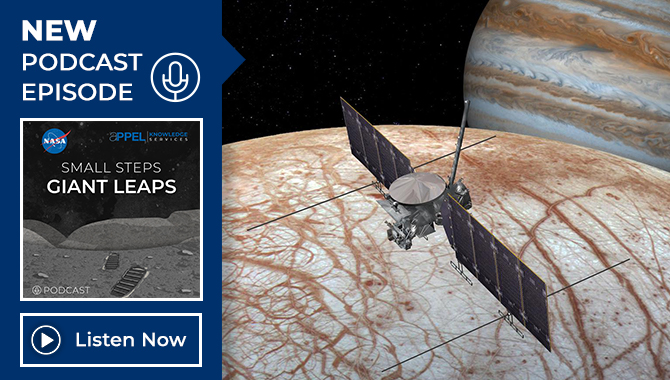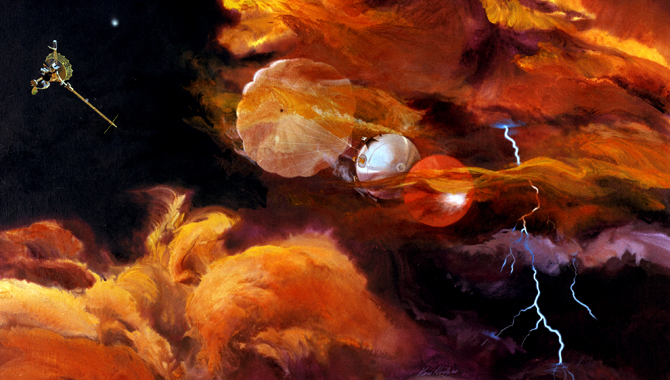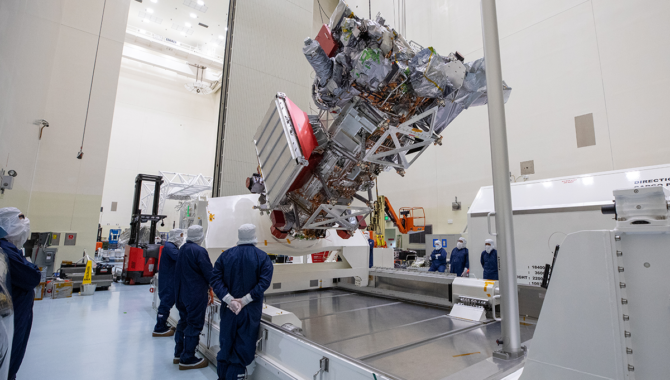
Technicians inside the Payload Hazardous Servicing Facility at NASA’s Kennedy Space Center in Florida prepare to rotate the Europa Clipper to a vertical position on Tuesday, May 28, 2024, as part of prelaunch processing. Photo Credit: NASA
By examining Jupiter’s icy ocean moon, scientists hope to determine if conditions are right to support life.
The first astronomers to observe Jupiter’s moon Europa more than 400 years ago initially thought it was a star in the night sky. But because it zips around the massive planet every 3.55 Earth days, travelling about 30,645 miles per hour, it soon became evident by its position in the night sky that it was actually a moon orbiting Jupiter. This left German astronomer Simon Marius and Italian astronomer Galileo Galilei trying to fit their observations into a larger theory of the solar system, with no way of knowing how fascinating Europa was.
Jupiter’s fourth-largest moon began to intrigue scientists in the 1970s. Images and data from NASA’s Pioneer 10, 11, and Voyager 2 missions revealed a surface with few craters compared to Jupiter’s other large moons. The moon’s thick ice surface appeared to have somehow erased signs of past impacts. Data also indicated that Europa could have a geologically active core.

These images show the trailing hemisphere of Jupiter’s moon Europa taken by the Galileo spacecraft at a distance of about 677,000 km. The left image shows Europa in approximately true color and the right image shows Europa in enhanced color to bring out details. The surface of Europa is predominantly ware-ice, the darker brown color is due to rocky material. The dark lines, some thousands of km long, are fractures in the crust. The bright feature towards the lower right of the disk is the 45 km diameter crater Pwyll, centered at 25.2 S, 271.4 W. Europa is 3122 km in diameter and north is up. Credit: NASA
NASA took a closer look at Europa in 1996, with the spacecraft Galileo. Images from the mission revealed a pale blue surface marked by dark, chaotic ridges and cracks. Scientists were surprised to find evidence of a magnetic field emanating from within the moon. Piecing together the data, the prevailing theory is that Europa has an ice surface between 10 and 15 miles thick, covering a vast ocean—2 billion cubic miles of water—as much as 100 miles deep. Scientists theorize that this saltwater could be warmed by the tidal interactions between Europa and Jupiter that cause Europa to flex regularly as it orbits the massive planet.
NASA is preparing a new spacecraft, the Europa Clipper, to launch in October on a 1.8 billion-mile, five-and-a-half-year journey, with gravity assists at Mars and Earth, arriving at Jupiter in 2030. The spacecraft will make dozens of passes by Europa, coming as close as 16 miles to the moon’s surface.
“…Scientists believe … Europa has the suitable conditions below its surface to be able to support life, and those ingredients are water, energy, and chemistry,” said Nicola Fox, NASA’s Associate Administrator for the Science Mission Directorate, speaking at a recent NASA press conference. “By studying this, by flying close to that moon and flying through the plumes that come up, it will help us better understand the astrobiology and the potential for a habitable world beyond our home planet.”
The Europa Clipper’s bus is about 10 feet wide, 15.5 feet tall, and 13 feet deep. In space, it will deploy two large, state-of-the-art solar arrays that will increase Europa’s span to more than 100 feet—the largest spacecraft NASA has sent on a planetary mission. At Jupiter, which receives less than 5 percent of the sunlight Earth receives, the arrays will combine to produce about 700 watts of electricity, enough to power the spacecraft’s suite of scientific instruments and communications equipment.
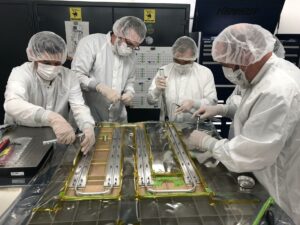
Europa Clipper technicians and engineers at NASA’s Jet Propulsion Laboratory in Southern California work together in a cleanroom on Sept. 12, 2019. They bond thermal tubing to the spacecraft’s Radio Frequency (RF) panel, which was built by Johns Hopkins University Applied Physics Laboratory (APL) in Laurel, Maryland. The tubing is part of a Heat Redistribution System (HRS) that pumps coolant all around the spacecraft and helps control its temperature as it travels through space. Photo Credit: NASA/JPL-Caltech
The Europa Clipper’s instruments include cameras to photograph the surface, a thermal imager to identify warmer areas of the frozen moon, a spectrograph to identify gases in the atmosphere, and a magnetometer to answer key questions about the thickness of Europa’s surface ice, determine if there is, in fact, a liquid ocean below, and gauge that ocean’s depth.
“We’ll also be sensing the magnetic field, which is helpful if you want to think about a circulating saline ocean, you should see magnetic results from that,” said Dr. Laurie Leshin, Director of NASA’s Jet Propulsion Laboratory. “We’re going to be looking at Europa in the ultraviolet, in the visible, with a narrow angle and a wide-angle camera. The images are going to be spectacular. And lastly, we will actually use our radio on board to sense the gravity around Europa. So, incredible science investigation, pretty much every wavelength and in-situ instruments, too.”
The team faced a challenge in early May when reports from users outside NASA indicated that radiation hardened metal-oxide-semiconductor field-effect transistors (MOSFETs), such as the ones installed on the Europa Clipper in multiple locations, were showing signs of damage from radiation exposures less than they were qualified to resist.
“First thing we did was get some spare parts in to test, and we confirmed exactly what had been said to our parts chief engineer,” said Jordan Evans, Europa Clipper Project Manager, noting that the issue appears to be caused by degradation during storage. “And that led to four months of round-the-clock testing at multiple locations around the country. It led to a quest for spare parts that were the exact lot date codes and part numbers of everything on the spacecraft and instruments and all of the circuit analyses.”
Radiation levels at Jupiter are incredibly harsh—as much as 1,000 times higher than those in low Earth orbit. This is likely driven by charged particles trapped within Jupiter’s powerful magnetosphere. The magnetosphere whips these energetic particles, concentrated in belts around Jupiter’s equator, to remarkable speeds—99.6 percent of the speed of light. Because they produce powerful bursts of radio waves, they have been observed by radio astronomers for more than 50 years.
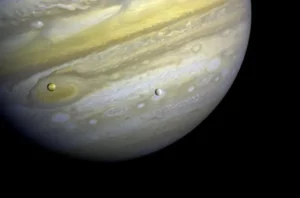
Voyager 1 took this photo of Jupiter and two of its satellites (Io, left, and Europa) on Feb. 13, 1979. Io is about 350,000 kilometers (220,000 miles) above Jupiter’s Great Red Spot; Europa is about 600,000 kilometers (375,000 miles) above Jupiter’s clouds. Photo Credits: NASA/JPL-Caltech
In the first half of Europa Clipper’s four-year primary mission, the spacecraft will orbit Jupiter once every 21 days. During the intense testing this Spring, the team calculated the spacecraft’s exposure to the most intense radiation, which occurs on a single day of orbit. The team’s research shows that some of the capacity lost during the time in the radiation zone will return in the days outside it through a restorative process in material science known as annealing.
“So, … annealing is at different temperatures, particularly at warmer elevated temperatures, the device itself, some of the positive and negatively charged particles that might migrate to one part under the radiation damage starts to migrate to different places. And that’s a process that is fairly well known…,” Evans said.
“So, we have 20 days outside of that [harsh radiation] environment,” Evans said. “All of the testing that we did when we looked at that annealing, we used durations that were far smaller than that, so we were conservative in our testing to show that we understood how much annealing time we would need and then demonstrate that we had far more than that with … each of the Jupiter orbits.”
This gave the team, and NASA, confidence to move forward toward a series of launch windows between October 10 and October 30. The Europa Clipper will launch aboard a SpaceX Falcon Heavy rocket from storied Launch Pad 39A at Kennedy Space Center.
“This team, they analyzed every circuit, they tested every kind of part. This was such an incredibly thorough job done by a team that has been working 24/7 since four months ago, when we found out about this issue,” Leshin said. “And to be able to sit here today and confidently say this mission is going to be awesome and we’re going to fly our baseline science is something that we’re so thrilled to be able to do, but it’s because of a bunch of hard work.”
To learn more about Europa and the Europa Clipper, click here.


